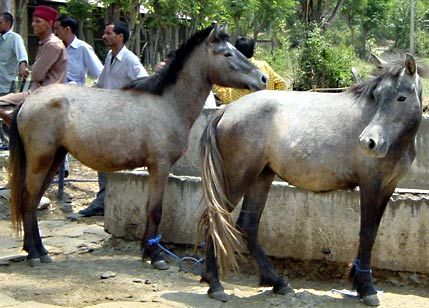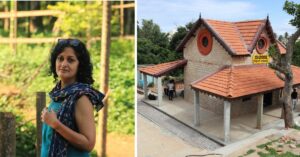A Village in Spiti’s Pin Valley Runs a Dedicated Insurance Scheme for Its Unique Horses
Tucked away in the interiors of the beautiful Pin valley in Spiti, the Sagnam village is a place where sublime beauty meets the practical struggle for survival. Home to the unique Chamurti horses, this Himalayan hamlet runs its own insurance scheme for its precious steeds!

Somewhere close to the Indo Tibetan border, in the Trans-Himalayan belt of Himachal Pradesh, lies a spectacular valley about which many haven’t heard of. The spellbinding Pin valley is a cold desert, a heady mix of austere barren mountains, unexpected bursts of green fields and deep gorges formed by the fierce Pin River, the Spiti river’s largest left bank tributary.
Tucked away in the interiors of this beautiful valley, the Sagnam village is a place where sublime beauty meets the practical struggle for survival. Home to the extraordinary Chamurti horses, this Himalayan hamlet runs its own insurance scheme for its precious equines!

Photo Source
Every spring, as the snow begins to melt in the mountains, the pastoralists of Sagnam open the barn doors and lead their whinnying horses out to the pastures beyond the River Pin. Here, the animals are left to free range for the coming months with no human in sight. While this ensures that the horses are never short of food, it also leaves them vulnerable to attacks by predators like snow leopards, brown bears and Himalayan wolves.
While it may seem cavalier to leave animals to free-range when they may be killed by predators, the villagers have no choice but to do this. During summer, snow melt coursing down the mountains transforms the River Pin, which separates the village from its pastures, into a roaring river. With the currents becoming to strong to wade through, it becomes nearly impossible to get the skittish horses to cross the river on the rickety wooden bridges.
Also Read: #TravelTales: Exploring Mechuka, Where Horses Run Wild and Friendly Tribes Reside
Also, the villagers cannot stay with the horses during this period as they must work in their fields to make ends meet. Until a decade ago, families took turns camping in the meadows and guarding the horses in the summer months but this changed when they began farming to sustain themselves. Presently, someone from the village treks to the pastures once a week to check on the animals and collect dung for their fields.

Photo Source
Without the constant presence of humans to watch over them, several horses are killed by predators during the summer months. Worried about this loss, both economic and personal, the villages decided to run their own innovative insurance scheme (with help from Nature Conservation Foundation) that compensates owners for the loss of their precious horses. These are, after all, not ordinary horses.
For centuries, the strong and sure-footed Chamurti horses have been used by the people of the Pin valley to transport silks, salt and other trade goods over the high mountain passes between Tibet and India. Distinctive, well-muscled mountain ponies, Chamurtis are believed to have descended from the hardy horses that ran wild across the steppes of Central Asia.

Photo Source
After the 1962 Sino-Indian War ended trade with Tibet, the Pin Valley became the Indian homeland of this unique equine breed. When the Indo-Tibetan Border Police began seeking these horses for deployment in their force, the demand for them shot up and the inhabitants of the valley began rearing more horses.
Sagnam, the largest village in Pin Valley, soon became home to the largest number of the Chamurti horses in India. The steeds also fetched good prices at the 300-year-old Lavi Trade Fair (held at the village of Rampur Bushar 300 km away).
However, the horses had been highly-prized by the villagers of Sagnam even before they became economically valuable. While there are other villages like Kibber and Kaza who also rear houses, none of them take care of the animals like Sagnam does. They take a lot of effort and set aside their own comforts to take care that their animals are always well-fed and comfortable. During autumn, they work from dawn to dusk to gather food for their precious beasts. When the mares are pregnant in winter, the villagers sleep next to them.
Photo Source
So, when the Himachal Pradesh Forest Department paid a measly Rs 1,500 as compensation for the death of a highli prized horse, it was hardly any support and assistance for the distressed villagers. Also, they had to travel all the way to Kaza (the sub-district headquarters) and go through a long-winded bureaucratic process to file their claims. Frustrated by official apathy, the beginners were beginning to turn hostile against the species that preyed on their horses when Nature Conservation Foundation volunteered to fund an insurance program in 2013.
Also Read: Ecosphere Spiti: Social Innovation at the Foothills of Himalayas
The Mysore-based NGO had already been working in seven other villages in Ladakh and Spiti to help conserve snow leopards. Conservationists knew that if the villagers’ grievances weren’t addresses, they would ultimately vent their anger on predators like snow leopards. In order to further co-existence in wildlife habitats where local people live and use natural resources, they knew that would need to estimate and offset economic costs.
So the organization proposed a scheme: if villagers were willing to pay a nominal amount for each animal, Nature Conservation Foundation would invest one-and-a-half times that amount to create the capital. The villagers were given the freedom to decide what premium to collect, what rules to impose, and how to manage the scheme.
They were also taught better anti-predatory livestock herding methods (that could reduce the extent of livestock losses to wild carnivores) and made aware about the importance of snow leopards, bears and wolves to surrounding ecosystem.
Photo Source
The insurance programme was received with great enthusiasm, though in the first year, some families were understandably skeptical. Although the horse owners receive just a fraction of the animal’s market value from the insurance program, they are happy to get something rather than nothing. Also, thanks to the awareness programmes, the villagers have stopped persecuting wild carnivores and driving them away from their kills.
Today, over 100 families in five villages of Spiti are participating and benefiting from this unique insurance programme. A similar sized programme covering four villages has also been started in the Gya-Miru region of Ladakh.
Contact Details:
Nature Conservation Foundation
3076/5, IV Cross, Gokulam Park,
Mysore 570002
Email: [email protected]
Also Read: Nomads of the Himalayas : A Fascinating Glimpse into the Rarely-Seen Forest World of the Van Gujjars
Like this story? Have something to share? Email: contact@thebetterindia.
NEW! Log into www.gettbi.com to get positive news on Whatsapp.
This story made me
- 97
- 121
- 89
- 167
Tell Us More
We bring stories straight from the heart of India, to inspire millions and create a wave of impact. Our positive movement is growing bigger everyday, and we would love for you to join it.
Please contribute whatever you can, every little penny helps our team in bringing you more stories that support dreams and spread hope.



















